
 John Cappa
Former Editor, Four Wheeler
John Cappa
Former Editor, Four Wheeler
For some reason, many JK Wrangler owners insist on installing tires larger than 35inches tall. This often results in a lot of axle-related failures, including prematurely worn ball joints, broken axleshafts, broken lockers, and bent front axle housings. The commonly adored 37-inch tires only net you about 1-inch more ground clearance than the 35s, but the 37s add quite a bit more weight and increased leverage that wreak further havoc, degrading the JKs steering and axle assemblies. To get the most out of your JK in factory trim, we think it's best to stick with 35s or smaller. That is, unless you plan to replace your axles with something more robust.
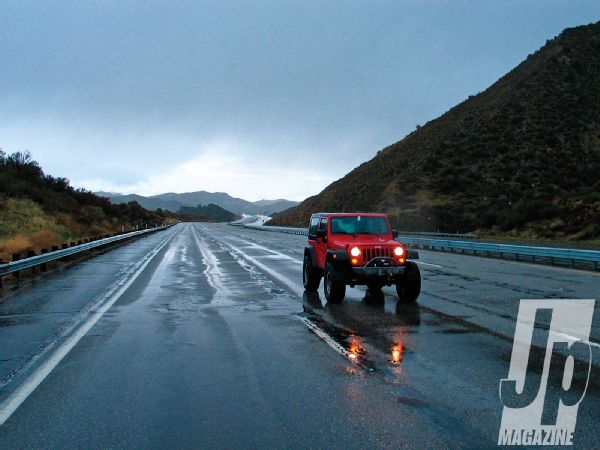
After accumulating about 30,000 miles on our lifted JK with 35s, some of our aftermarket suspension components were worn out beyond useable condition. During that time we came to the conclusion that we liked the way our JK rode and drove better with the stock suspension on it. However, we appreciated the additional clearance that the 35s afforded. So we set out to find a way to keep the big tires and regain the factory-like ride, handling, and performance both on- and off-road. And since the '07-up Wrangler is already a bit portly, we investigated wheel and tire selections to save weight and regain a small amount of lost engine performance. Here's what we came up with after a bit of testing and wrenching. In this case, less is more.
 We haven't had much luck with aftermarket rubber or urethane control arm bushings. Just less than 30,000 miles of on- and off-road use destroyed these bushings. This caused clunking and driveline vibration. The sleeves no longer fit tight and fell right out when we removed the arms. The factory bushings (top) are light years better. Why doesn't anyone use the stock rubber bushings in aftermarket control arms? The unspoken truth is that they will generally outlast just about anything else out there.
We haven't had much luck with aftermarket rubber or urethane control arm bushings. Just less than 30,000 miles of on- and off-road use destroyed these bushings. This caused clunking and driveline vibration. The sleeves no longer fit tight and fell right out when we removed the arms. The factory bushings (top) are light years better. Why doesn't anyone use the stock rubber bushings in aftermarket control arms? The unspoken truth is that they will generally outlast just about anything else out there.
But I Really Want 37s!
Of course you do, but maybe you're not totally aware of the worm can you're opening when you step up to 37-inch tires. The drawbacks outweigh the benefits of the bigger meats for most of us. The truth is that if you really use your Jeep you'll likely bend the front axlehousing and prematurely wear out steering components with 35s anyway. But consider that a typical 37-inch mud tire weighs about 10 pounds more than a typical 35-inch mud tire. That may not seem like much, however it's rotating weight, meaning it's added weight that your engine has to turn and your brakes have to stop. The general rule of thumb is that every 10 pounds of wheel weight equals 100 pounds of carried weight inside the Jeep. So by going with the 37s instead of the 35s, you effectively add another 400 pounds of cargo to your Jeep. That will be a significant drag in the horsepower department, and we haven't even considered the gearing situation yet. A 35-inch tire is about 8 percent larger than the stock Rubicon tire. You can, in many cases, get by with the stock axle gears (less true if you have an automatic transmission). The 37-inch tires are over 14 percent larger than the stock tires and will require a gear swap to make your Jeep more drivable and less of a pig on-road. If you plan to stick with 37s, are you sure you want to toss money into those stock axles that likely won't hold up?
Jeep Wrangler JK Front Suspension
Up front we pitched nearly all of our 3-inch lift kit. The only things we retained were the brake line extensions. Our Jeep has an aftermarket steel front bumper and a winch. The factory JK front coils are incredibly light to provide a good ride but they will compress under this additional weight. So in place of the aftermarket lift coils we installed the stock coils along with Daystar 3-inch urethane coil spacers and bumpstop extensions. We reinstalled the factory JK upper and lower control arms as well as the original forged track bar and sway bar links. The stock shocks were reused too but we fitted them with Rubicon Express extensions (PN RE2003). With everything in place we set the Jeep back on the ground and centered the steering wheel by adjusting the drag link. Make sure you get this adjustment as close to perfect as possible or the Jeep's Electronic Stability Program (ESP) will freak out.
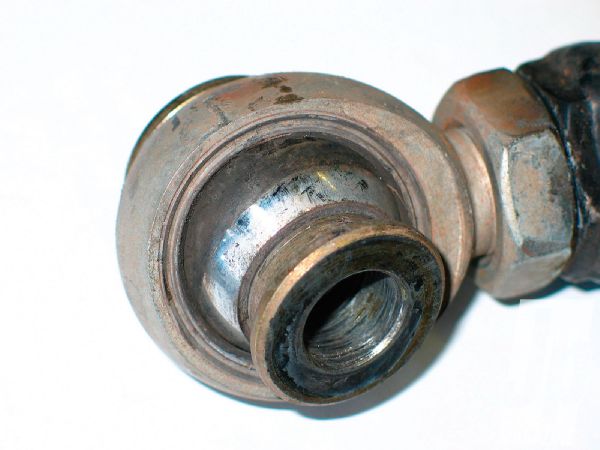 We also found that the rod end in the aftermarket front track bar gave up the ghost. It was a quality rod end but it's in an abusive application. The 3/4-inch rod end had spit out its Teflon liner and became very loose and sloppy. Not a particularly good characteristic for a track bar when you want crisp handling and no death wobble. Again, it's hard to beat the factory rubber bushings.
We also found that the rod end in the aftermarket front track bar gave up the ghost. It was a quality rod end but it's in an abusive application. The 3/4-inch rod end had spit out its Teflon liner and became very loose and sloppy. Not a particularly good characteristic for a track bar when you want crisp handling and no death wobble. Again, it's hard to beat the factory rubber bushings.
Jeep Wrangler JK Rear Suspension
In the rear we went back to basics. Out came the aftermarket 3-inch lift coils, aftermarket lower control arms, and aftermarket shocks. In their place we installed the factory rear JK coils along with Daystar 1.75-inch urethane coil spacers. Make sure the rear coils are seated properly or the coil on the passenger side will rub on the track bar. To keep axle movement in check we slapped in the factory lower control arms and the Daystar sway bar spacers. The factory shocks were reinstalled thanks to the rear shock extensions (PN RE2004) from Rubicon Express. Since our two-door JK has a J.E. Reel 1310 CV-style rear driveshaft we needed some way to rotate the axle upward to keep the driveshaft in line. To get that adjustability we added Rubicon Express Super Flex upper control arms (PN RE3757). Don't waste your time with adjustable cam bolts unless your Jeep is mostly a street machine. Egging out control arm mounting holes is never a good idea and isn't as easy as it might seem. We retained the factory rear track bar and then rounded out our short lift with Black Diamond 3-inch-lift sway-bar links, bumpstops, brake line extensions, and track bar axle bracket. To clear the 35s cleanly at full stuff you will likely need to pound back or trim just a bit from the pinch seams in the lower forward part of the rear wheelwells.
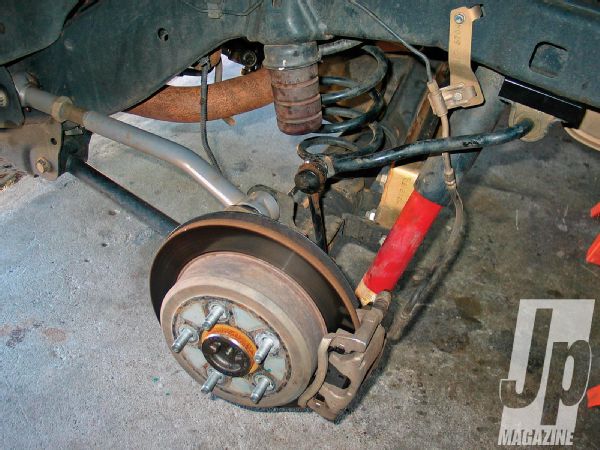 Once the rear axle is rotated up for better driveshaft angles, the rear coils can bind-more so on the two-door JKs than the four-doors (depending on the amount of lift) due to the shorter wheelbase.
Once the rear axle is rotated up for better driveshaft angles, the rear coils can bind-more so on the two-door JKs than the four-doors (depending on the amount of lift) due to the shorter wheelbase.
How's It Work?
We've put over 5,000 miles on our pieced-together lift kit. Overall the Jeep is more pleasant to drive both on- and off-road. The valving in the stock shocks combined with the factory coils provides a soft ride without upsetting the sensitive ESP system. The Jeep feels really stable. The front end has a decent 5 degrees of positive caster and we set the alignment at 1/8-inch toe-out to eliminate the slight shimmy at lower speeds.
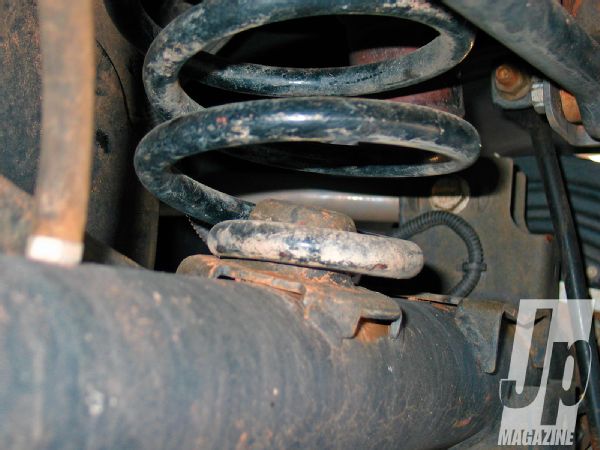 To correct the problem, Rubicon Express offers new heavy-duty spring and bumpstop pads (PN RE9830 and PN RE9831) that you can weld to your axle in the proper locations once you cut off the old ones.
To correct the problem, Rubicon Express offers new heavy-duty spring and bumpstop pads (PN RE9830 and PN RE9831) that you can weld to your axle in the proper locations once you cut off the old ones.
There is less head toss when traversing driveways on-road and staggered rocks or holes off-road. We typically run the 35x12.50R17 Goodyear MT/R tires at 25psi front and rear on the street and 12psi or lower in the snow, mud, rocks, dirt, and sand. The rear of our two-door JK sits just a bit higher (maybe 1/2- to 3/4-inch) but we are still running the stock rear bumper and no rear seat. As a bonus, the slightly forward stance keeps the hood from buffeting at freeway speeds. If your Jeep has the stock bumpers front and rear you should get good results with 1.75- to 2-inch spacers front and rear. Although if you want your stock-bumpered '07-present Wrangler to sit level you might be better off with a 3-inch spacer up front and a 1-inch spacer in the rear. We're currently working with Bilstein to come up with longer soft-valved shocks for people like us that want a smoother ride and don't mind a little sway in the corners.
Wheel and Tire Selection
Of course we'd all love to have the look of an aggressive luggy mud tire with burly looking beadlock wheels. But most of us can't just build for the weekend, we have to drive the Jeep to work on Monday. Comfort, drivability, tire wear, and fuel economy often take precedence over our dream tires. For all-around best performance you should look for the lightest tire and wheel combo that meets your needs on- and off-road. We like the performance we get from a good mud tire, and we've been really happy with our aluminum 17x8.5 AEV Pintler beadlock wheels. So we set out to find a durable lightweight tire with some meaty lugs. We found that 35x12.50R17 tire weights ranged from 61 to 83 pounds each! We also found that by switching to comparable 15-inch tires and wheels (which will fit on a JK with 3.50 to 3.75 inches of backspacing) we could drop over 10 pounds per corner in some cases. But not all 15-inch wheels will fit your JK, so do your research before buying. We ended up with some 35x12.50R17 Goodyear MT/R Kevlar tires (far right) that weighed in at 64 pounds apiece. They are 14 pounds lighter than the 35-inch tires that were on our Jeep. That's a total loss of 56 pounds of rotating weight, which will help us in the performance department.
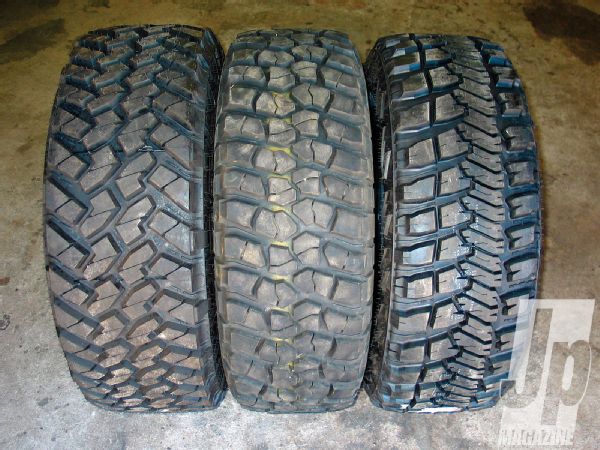 PhotosView Slideshow
PhotosView Slideshow

